Thoracoabdominal aortic aneurysm repair: current endovascular perspectives
- PMID: 25170271
- PMCID: PMC4145733
- DOI: 10.2147/VHRM.S46452
Thoracoabdominal aortic aneurysm repair: current endovascular perspectives
Abstract
Thoracoabdominal aneurysms account for roughly 3% of identified aneurysms annually in the United States. Advancements in endovascular techniques and devices have broadened their application to these complex surgical problems. This paper will focus on the current state of endovascular thoracoabdominal aneurysm repair, including specific considerations in patient selection, operative planning, and perioperative complications. Both total endovascular and hybrid options will be considered.
Keywords: TEVAR; endovascular surgery; thoracic aorta; thoracoabdominal aneurysm.
Figures








References
-
- Stein L, Elefteriades J. Epidemiology and natural history of thoraco-abdominal aortic aneurysms. In: Chiesa R, Melissano G, Zangrillo A, editors. Thoraco-Abdominal Aorta. Springer; Milan: 2011. pp. 25–32.
-
- Clouse WD, Hallett JW, Jr, Schaff HV, et al. Improved prognosis of thoracic aortic aneurysms: a population-based study. JAMA. 1998;280(22):1926–1929. - PubMed
-
- Knepper J, Upchurch GR. A review of clinical trials and registries in descending thoracic aortic aneurysms. Semin Vasc Surg. 2010;23(3):170–175. - PubMed
-
- Crawford ES, Coselli JS. Thoracoabdominal aneurysm surgery. Semin Thorac Cardiovasc Surg. 1991;3(4):300–322. - PubMed
-
- Safi HJ, Miller CC., 3rd Spinal cord protection in descending thoracic and thoracoabdominal aortic repair. Ann Thorac Surg. 1999;67(6):1937–1939. discussion 1953–1958. - PubMed
Publication types
MeSH terms
LinkOut - more resources
Full Text Sources
Other Literature Sources

